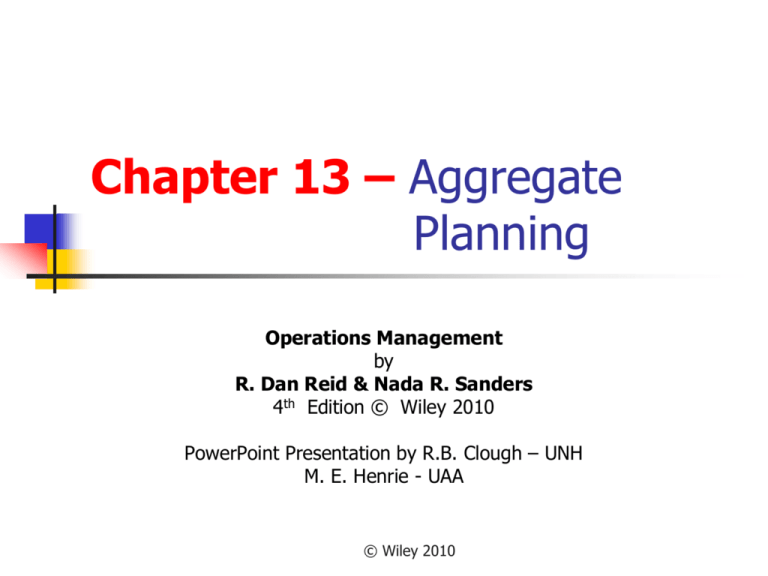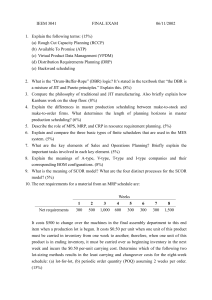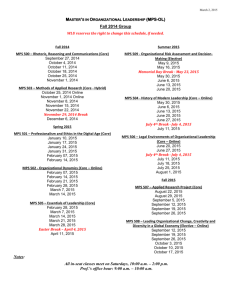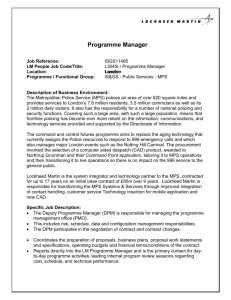
Chapter 13 – Aggregate
Planning
Operations Management
by
R. Dan Reid & Nada R. Sanders
4th Edition © Wiley 2010
PowerPoint Presentation by R.B. Clough – UNH
M. E. Henrie - UAA
© Wiley 2010
The Role of Aggregate
Planning
Integral to part of the business planning
process
Supports the strategic plan
Also known as the production plan
Identifies resources required for
operations for the next 6 -18 months
Details the aggregate production rate
and size of work force required
© Wiley 2010
The Role of the Aggregate Plan
© Wiley 2010
Planning Links to MPS
© Wiley 2010
Types of Aggregate Plans
Level Aggregate Plans
Maintains a constant workforce
Sets capacity to accommodate average demand
Often used for make-to-stock products like appliances
Disadvantage- builds inventory and/or uses back orders
Chase Aggregate Plans
Produces exactly what is needed each period
Sets labor/equipment capacity to satisfy period demands
Disadvantage- constantly changing short term capacity
© Wiley 2010
Types of Aggregate Plans
(Cont.)
Hybrid Aggregate Plans
Uses a combination of options
Options should be limited to facilitate execution
May use a level workforce with overtime & temps
May allow inventory buildup and some backordering
May use short term sourcing
Best way to develop a hybrid plan is by Linear Programming or
Integer Linear Programming, see notes given in class and
http://bcs.wiley.com/he-bcs/Books?action=mininav&bcsId=3598&itemId=0471794481&assetId=112492&resourceId=10280&newwindow=true
© Wiley 2010
Aggregate Planning Options
Demand based options
Reactive: uses finished goods inventories and
backorders for fluctuations
Proactive: shifts the demand patterns to minimize
fluctuations e.g. early bird dinner prices at a restaurant
Capacity based options
Changes output capacity to meet demand
Uses overtime, under time, subcontracting, hiring, firing,
and part-timers – cost and operational implications
© Wiley 2010
Developing the Aggregate Plan
Step
Step
Step
Step
1234-
Choose strategy: level, chase, or Hybrid
Determine the aggregate production rate
Calculate the size of the workforce
Test the plan as follows:
Calculate Inventory, expected hiring/firing, overtime needs
Calculate total cost of plan
Step 5- Evaluate performance: cost, service,
human resources, and operations
© Wiley 2010
Aggregate Planning Bottom Line
The Aggregate plan must balance several
perspectives
Costs are important but so are:
Customer service
Operational effectiveness
Workforce morale
A successful AP considers each of these factors
© Wiley 2010
Master Production Scheduling
Master production schedule (MPS) is the
anticipated build schedule
MPS is often stated in produce or
service specifications rather than dollars
MPS is often built, managed, reviewed
and maintained by the master scheduler
© Wiley 2010
Planning Links to MPS
© Wiley 2010
Role of the MPS
Aggregate plan:
Specifies the resources available (e.g.: regular
workforce, overtime, subcontracting, allowable
inventory levels & shortages)
Master production schedule:
Specifies the number & when to produce each
end item (the anticipated build schedule)
Disaggregates the aggregate plan
© Wiley 2010
Objectives of Master Schedule
The Master Scheduler must:
Maintain the desired customer service level
Utilize resources efficiently
Maintain desired inventory levels
The Master Schedule must:
Satisfy customer demand
Not exceed Operation’s capacity
Work within the constraints of the Aggregate Plan
© Wiley 2010
MPS as a Basis of
Communication
MPS is a basis for communication between
operations and other functional areas
Demand management and master scheduler
is communication is ongoing to incorporate
Forecasts, order-entry, order-promising, and
physical distribution activities
Authorized MPS is critical input to the
material requirements planning (MRP)
© Wiley 2010
Developing an MPS
The Master Scheduler:
Develops a proposed MPS
Checks the schedule for feasibility with available capacity
Modifies as needed
Authorizes the MPS
Consider the following example:
Make-to-stock environment with fixed orders of 125 units
There are 110 in inventory to start
When are new order quantities needed to satisfy
the forecasted demand?
© Wiley 2010
The MPS Record
W eek
BI
1
2
3
4
5
6
7
8
9
10
11
12
50
50
50
50
75
75
75
75
50
50
50
50
110
60
10
-4 0
BI
1
2
3
4
5
6
7
8
9
10
11
12
50
50
50
50
75
75
75
75
50
50
50
50
60
10
85
35
-4 0
F o re c a s t
P ro je c t e d a va ila b le
MPS
W eek
F o re c a s t
P ro je c t e d a va ila b le
MPS
110
125
Projected Available = beginning inventory + MPS shipments forecasted demand
The MPS row shows when replenishment shipments need to arrive to avoid a
stock out (negative projected available)
© Wiley 2010
Revised and Completed MPS Record
W eek
BI
F o re c a s t
P ro je c te d a va ila b le
110
1
2
3
4
5
6
7
8
9
10
11
12
50
50
50
50
75
75
75
75
50
50
50
50
60
10
85
35
85
10
-6 5
MPS
W eek
125
BI
F o re c a s t
P ro je c te d a va ila b le
MPS
110
125
1
2
3
4
5
6
7
8
9
10
11
12
50
50
50
50
75
75
75
75
50
50
50
50
60
10
85
35
85
10
60
110
60
10
85
35
125
125
125
125
© Wiley 2010
125
Evaluating the MPS
Rough-cut capacity planning:
An estimate of the plan’s feasibility
Given the demonstrated capacity of critical
resources (e.g.: direct labor & machine time),
have we overloaded the system?
Customer service issues:
Does “available-to-promise” inventory satisfy
customer orders? If not, can future MPS quantities
be pulled in to satisfy new orders?
© Wiley 2010
Stabilizing the MPS
© Wiley 2010
Aggregate Planning Across the
Organization
Aggregate planning, MPS, and rough-cut
capacity affection functional areas throughout
the organization
Accounting is affected because aggregate plan
details the resources needed by operations
Marketing as the aggregate plan supports the
marketing plan
Information systems maintains the databases that
support demand forecasts and other such
information
© Wiley 2010
Chapter 13 Highlights
Planning begins with the development of the strategic
business plan that provides your company’s direction and
objectives for the next two to ten years.
Sales and operations planning integrates plans from the
other functional areas and regularly evaluates company
performance.
The level aggregate plan maintains the same size workforce
and produces the same output each period. Inventories and
backorders absorb fluctuations in demand. The chase
aggregate plan changes the capacity each period to match
the demand
Demand patterns can be smoothed through pricing
incentives, reduced prices for out-of-season purchases, or
nonprime service times.
© Wiley 2010
Chapter 13 Highlights
(continued)
The difference in aggregate planning for companies that do
not provide a tangible product is that the option to use
inventories is not available
The MPS shows how the resources authorized by the AP will
be used to satisfy the organizational objectives. The MPS
specifies the products to be built in each time period. MPS is
checked for feasibility using a rough-cut capacity planning
technique.
The objectives of master scheduling are to satisfy customer
service objectives, use resources effectively, and minimize
costs. An MPS is developed by looking at individual MPS
records and calculating when replenishment quantities are
needed. The MPS records are summed together to show
the total proposed workload. © Wiley 2010
Chapter 13 Highlights
(continued)
Available-to-promise logic is used when
promising order delivery dates to customers,
ATP logic allows the company to make viable
delivery promises
Time fence policies stabilize the MPS. The
demand time fence and the planning time
fence divide the MPS into three portions:
frozen, slushy, and liquid.
© Wiley 2010
The End
Copyright © 2007 John Wiley & Sons, Inc. All rights reserved.
Reproduction or translation of this work beyond that permitted
in Section 117 of the 1976 United State Copyright Act without
the express written permission of the copyright owner is
unlawful. Request for further information should be addressed
to the Permissions Department, John Wiley & Sons, Inc. The
purchaser may make back-up copies for his/her own use only
and not for distribution or resale. The Publisher assumes no
responsibility for errors, omissions, or damages, caused by the
use of these programs or from the use of the information
contained herein.
© Wiley 2010
Aggregate Production Planning
Extra Credit: Linear Programming Formulation
Parameters: found in or computed from the data
Decision variables: unknowns to be determined
Objective function: the bottom line
Constraints: Satisfy demands and state relationships
among variables
Single Product model here; can be generalized
Parameters: find these in the data!
dt = amount of product demanded in period t
pt = productivity per worker in period t
Lt = unit labor cost per worker in period t
ht = unit hiring cost per worker in period t
ft = unit firing cost per worker in period t
Parameters: find these in the data!
ct = inventory holding cost per
unit per period in period t
at = backorder cost per item
per period in period t
Decision Variables:
find values by solving the model
wt = number of workers employed in period t
ut = number of workers hired between periods t-1
and t
vt = number of workers fired between periods t-1
and t
it = amount of product in inventory at the end of
period t
bt = amount backordered at the end of period t
Initial values:
“fixed variables”; find in data
io = initial inventory level
wo = initial workforce level
bo = initial backorder, i.e., left
over from previous period.
The LP Model
Minimize t (Ltwt + htut + ftvt + ctit + atbt)
s.t.
ut - vt = wt – wt-1 for each period t : workforce change
ptwt + it-1 - it + bt – bt-1 = dt for each period t: demand
balance
iT==0, bT = 0 for last period T; closing out
wt, ut, vt, it, bt 0 for each time period t: nonnegativity
© Wiley 2007
The LP model for the example
Minimize 1280w1+1280w2 +…+ 500u1+500u2
+…+ 1000v1+1000v2+…+10 i1 + 10 i2 +…+
100 b1 + 100 b2+…
s.t.
u1 – v1 = w1 – 210 (period 1)
…
26.67w1 + io – i1 + b1 – bo = 6000 (period 1)
26.67w1 + io – i1 + b1 – bo = 4800 (period 2)
…
All variables nonnegative
© Wiley 2007
Some loose ends: SCM
Supply Chain Strategy
http://money.cnn.com/2008/05/28/magazines/fortun
e/kapner_walmart.fortune/index.htm
Wal-Mart puts the squeeze on food costs The retailer
is using its clout with vendors to hold onto its
everyday low prices
A company’s supply chain strategydetermines the
nature of procurement and transportation of
materials as well as manufacture and distribution of
the product.
© Wiley 2007
Some loose ends: SQC
the primary reason for abandonment of the
inspection system and the adoption of the Statistical
Process Control system for achieving quality in the
was that customer expectations were raised by
Japanese quality during the late 70s.
© Wiley 2007
Heuristic #1:
Choose the Cheapest Warehouse to Source
Demand
D = 50,000
$2 x 50,000
$5 x 140,000
Cap = 60,000
$2 x 60,000
D = 100,000
$1 x 100,000
$2 x 50,000
D = 50,000
Total Costs = $1,120,000
Source: Simchi-Levi, Kaminsky & Simchi-Levi, Designing and Managing the Supply Chain 3/e
© Wiley 2007
Heuristic #2: Choose the warehouse where the
total delivery costs to and from the warehouse are
the lowest [Consider inbound and outbound
distribution costs]
$0 x 50,000
D = 50,000
$3 x 50,000
Cap = 200,000
P1 to WH1
P1 to WH2
P2 to WH1
P2 to WH 2
$5 x 90,000
D = 100,000
P1 to WH1
P1 to WH2
P2 to WH1
P2 to WH 2
$1 x 100,000
Cap = 60,000
$3
$7
$7
$4
$2 x 60,000
$2 x 50,000
D = 50,000
Total Cost = $920,000
Source: Simchi-Levi, Kaminsky & Simchi-Levi, Designing and Managing the Supply Chain 3/e
© Wiley 2007
$4
$6
$8
$3
P1 to WH1
P1 to WH2
P2 to WH1
P2 to WH 2
$5
$7
$9
$4







